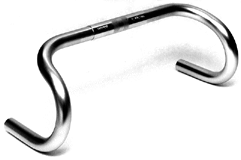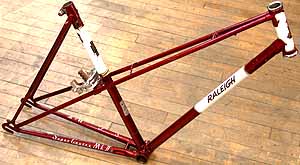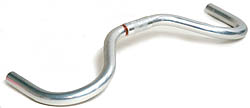Sheldon Brown's
Bicycle Glossary M

|
![]()
The seam may be welded, or, in the case of a lightweight, hollow-section rim, it may be made by fitting a short metal pin into the hollow at each end. (This part is sometimes called a "biscuit.")
The seam area is never exactly perfect; there is commonly a very slight difference in width or alignment. Excess welding material is commonly ground down too far, creating a slight hollow; or the two ends of a pinned rim may be slightly out of alignment. When a brand-new rim is first used (with a rim brake), the brake may pulsate annoyingly. Generally, this goes away after a couple of hundred miles of use, as the brake shoes wear down the irregularity of the seam.
Sometime in the 1990s, Mavic introduced its "SUP ® " rims (Soudé Usine Process: “Factory Welded Process”. The French version isn't all French: it's marketeerese -- "process" is English. Mavic could expect a visit from the French Language Police any day now... see my article "Derailer, not Derailleur"). But anyway.
These rims are made with an extrusion slightly wider than normal, with extra thickness on the braking surfaces. Mavic uses a welded seam (not normally practical on a thin-walled hollow-section rim) and then, after the seam is welded, the rim is placed on a special lathe where the excess material from the sidewalls is machined away uniformly.
Other companies have copied parts of this process, using machining on both welded- and pinned-joint rims. Rims with machined braking surfaces have two advantages:
There is a potential drawback to this type of rim, though: If the alignment of the two ends is less than perfect at the weld, the machining process can leave part of the sidewall thinner than it was designed to be. This can cause the rim to wear out from braking friction locally sooner than it otherwise would.
| The Maes bend is the most common type of drop handlebar. From the center, it goes straight out then bends forward in a gradual curve. When it has bent forward 90 degrees, it turns downward, and bends in a smooth, constant-radius curve approximately 160 degrees, then straightens out.
It is usually set at an angle such that the forward-bending section is tilted somewhat downward toward the front. The bottom flat part of the "drops" will normally be level, or slightly down at the rear. It should be adjusted for straight wrists when the hands are resting on the drops. |
 |
![]()
![]()
In the bicycle world, especially the BMX and Freestyle realm, the term "mag wheel" is used to refer to molded glass fiber-reinforced plastic wheels, typically with 3-6 molded"spokes" as opposed to traditional wire-spoked wheels. The best-known brand is "Tuff Wheels".
In the early days of BMX there were metal "mags" made of pot metal, such as "Lester Mags".
As far as I know, nobody has ever made bicycle wheels out of magnesium. The term "mag wheel" is just a slang term for any type of molded one-piece wheel.
"Mag" wheels are heavier than spoked wheels, and the rims can't generally handle high tire pressures, but the wheels themselves are very strong and resilient, good for abusive riding applications.
"MAFAC" is an acronym from: "Manufacture Auvergnoise de Freins et Accessoires pour Cycle" (Manufacturer in the Auvergne of Brakes and Accessories for Cycles.)

The Craig Super Link, SRAM Power Link, KMC Missing Link and Wipperman Connex are special master links that work with derailer gearing, and a good choice for a cyclist who wishes to be able to remove the chain for cleaning.
The article about chain cleaning includes more information about master links.
Mathauser is best known as a manufacturer of brake shoes. They are a distinctive ugly rust-red color, but they are the best that I have come across. They provide excellent stopping power wet or dry, and are very long-lasting. I recommend them highly. Brake shoes using Mathauser's technology are also manufactured under license by Kool Stop.
![]()
![]()
 A traditional upholstered saddle, as used on older, less-expensive English 3-speeds (better models used leather saddles.) A mattress saddle has multiple small coil springs running along between the front and rear of the frame, covered with a layer of felt or horsehair, and a leatherette/vinyl top. This type of saddle almost always has large coil springs at the back of the frame.
A traditional upholstered saddle, as used on older, less-expensive English 3-speeds (better models used leather saddles.) A mattress saddle has multiple small coil springs running along between the front and rear of the frame, covered with a layer of felt or horsehair, and a leatherette/vinyl top. This type of saddle almost always has large coil springs at the back of the frame."MAVIC" is an acronym from "Manufacture d'Articles Véloçopédiques Idoux et Chanel. (Idoux and Chanel were the names of the partners who founded the company in 1890.)
For a more thorough explanation of mechanical advantage, see my article on Cantilever Brakes.
A quick and easy way to convert from meters development to inches is to divide by 0.08. To convert from gear inches to meters development, multiply by 0.08.
You can calculate gain ratios., gear inches or meters development with my Online Gear Calculator or with your slide rule
Most wrenches used on bicycles have sizes in millimeters.
The most common sizes are 8 mm, 9 mm, 10 mm, 13 mm, 14 mm, 15 mm, 17 mm, 32mm and 36 mm; also, Allen wrenches in 4 mm, 5 mm, 6 mm and 8 mm.
Less common are 7 mm, 11mm, 12mm 16 mm and 19 mm, 30 mm, 40 mm and Allen sizes 2mm, 2.5 mm, 3 mm, 7 mm and 10 mm.
Metric threads are specified by diameter followed by the thread pitch (distance between threads)
For example, the common "M5" thread used for water bottle mounts, cable anchor bolts, fender/rack eyelets, shifter mounts etc. on bicycles is more specifically described as "5.0 x 0.8", which specifies a 5 mm diameter, with threads 0.8 mm apart.
Similarly, the common "M6" thread used for brake mounting bolts, threadless stems, many seatpost bolts and so forth is actually "M6.0 x 1.0" That's 6 mm diameter, threads 1 mm apart.
Normal coarse metric threads are commonly designated with the letter "M" followed by the diameter, with the thread pitch understood. For example:
I have developed a color-coding system for quickly determining the size of a Metric wrench. This is explained in my article on Color Coding Your Tools.
![]()
![]()
When seatposts with built-in clamps came onto the market, one of the major advantages that they were touted for was that you had a continuous range of angle adjustments, achievable by loosening the front bolt and tightening the rear (or vice versa). The buzzword to describe this feature was "micro-adjustable". This term came to become a general synonym for a seatpost with a built-in clamp, as opposed to the older "pipe" style.
Most newer seatposts are single bolt designs, and rely on serrations to maintain the saddle angle (the serrations are finer-pitched than the old saddle clamps). Despite the fact that these seatposts do not provide a truly continuous adjustment, they are still commonly referred to as "microadjustable." Also see Laprade.
For more on seatposts, see my article on Saddles.
A more prosaic name for this is "fish-mouth."
The accuracy and precision of the mitering of the frame tubes is fairly critical. In the case of a lugged frame, a sloppy builder can usually get away with less-than-perfect niters, since the miters are mostly not visible, hidden inside of the lugs. Even so, the frame will be stronger if the miters are well fitted. With lugged frames, the quality of the mitering can often be judged by looking at the inside of the bottom bracket, where the seat tube, down tube and seatstay miters will usually be visible.
Some investment-cast lugs are designed to provide a stepped socket that accepts a square-cut tube. This makes mitering unnecessary

Mixte frames are stronger than conventional lady's frames, particularly in resisting the tendency of the seat tube to get pushed backward in the middle when ridden by a heavy rider.
In French, "mixte" is pronounced "MEExt", but normal U.S. bicycle industry pronunciation is "MIX-ty".
![]()
![]()
Some road racers train behind a motorcycle, which allows the coach to accompany the rider, and teaches the cyclist to be comfortable controlling the bicycle at higher-than-average speeds.
Early Moultons used a simple cross frame of large-diameter steel tubing, with a reinforcing strut for the seat tube. The current "AM" series uses a very elaborate "space frame", consisting of a network of many pieces of small-diameter steel tubing, lined together into a truss made up of many small triangles. AM models are designed to separate into two roughly equal-sized pieces for ease of transport. There is also an "APB" model with 406 mm (20") wheels.
The mountain bike is in many ways a hybrid design, a cross between a BMX bicycle and a touring bicycle.

Drew Saunders has a Web document devoted to the Moustache handlebar.
![]()
![]()
![]()
Last Updated: by Harriet Fell